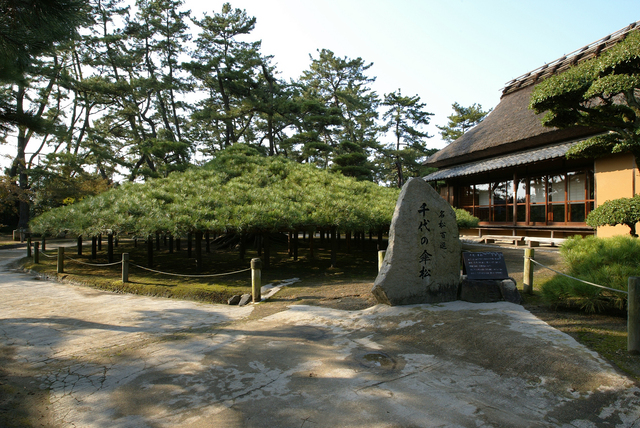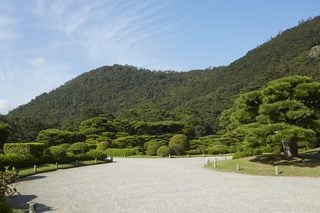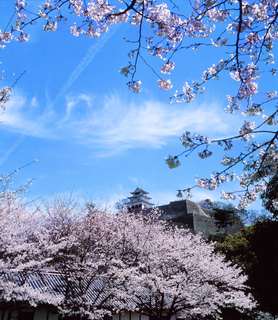Nakatsu Banshoen is a grand Japanese-style garden that was made for Kyogoku Takatoyo, the second-generation feudal lord of Marugame. The garden, built on land that had been praised for its beauty since the Asuka era (around the 6th century AD), was modeled after Lake Biwako and Ohmi-Hachiman in what was then the province of Ohmi, the original lands of the Kyogoku clan. The garden was a place for the successive lords of the clan to enjoy tea; there still remain two teahouses. Of those two, Kanchoro house is said to be the oldest existing teahouse for the Sencha (a sort of Japanese brewed tea) ceremony in Japan.
This house is built with the floor elevated above ground level; it is believed that inhabitants enjoyed tea, appreciating the view of the sea as well as the garden itself. Such a style of a Sencha teahouse is not found elsewhere, making the elegant atmosphere a very unique one. (The name Kanchoro literally means “a house to watch the tide” in Japanese). There are other facilities including an art gallery and a pottery gallery on the same premises. It will take around one hour, maximum, to walk around while enjoying the scenery.
YOGETSUBASH
The first thing you will notice will be Yogetsubashi, a vermilion-lacquered foot bridge. Standing in the middle of it you can get a view of the whole garden with situated trees and water springs. From the representative spot you can enjoy the elegance of the Japanese-style garden, with egrets all around.
OGASAMATSU – PINE TREE
The 600-year-old pine tree called “Chiyono-kasamatsu,” which literally means “umbrella pine tree of a thousand years”, stands to the west of the main house. The trunk of the tree is about 15 meters across, and it is shaped like an umbrella. This pine tree is said to have been taken from the province of Ohmi and it was made into that shape, in which it has spent more than 300 years. It is believed to have been modeled after Mt Fuji, and it takes as many as 30 people to trim the whole
tree.
tree.
GALLERIES
Other attractions of this garden are the painting gallery and pottery gallery. The painting gallery collects pieces by painters belonging to the Barbizon School, especially the so-called seven stars of Barbizon, including Millet and Collot. The pottery gallery exhibits the earthenware, ceramics and glassware excavated in present-day Iran and Iraq, created between 2500 BC and the 13th century AD.
INFORMATION - NAKASUBANSHOEN
[Address] 25-1 Nakazu-cho Marugame, Kagawa
[Opening Hours] 9:00-17:00
[Closed] Open 365 days of the year
[Admission] Adult: 1,000 yen, Students: 600 yen, Children under 15: 400 yen
[Opening Hours] 9:00-17:00
[Closed] Open 365 days of the year
[Admission] Adult: 1,000 yen, Students: 600 yen, Children under 15: 400 yen
13 records
 FIND SHIKOKU
FIND SHIKOKU












